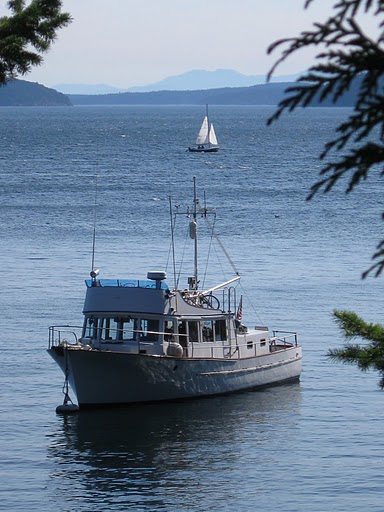So what is with this Power Boat thing? I thought people who cruised did it in Sail boats, or if they wanted to really be hip maybe a Cat... How can you be thinking of doing something like this in a Power Boat?
Well. First off. I love sail boats. More correctly, I love sailing. Before Viking Star I had a sail boat, and would get Sails Up 2-3 times a week during the summer. (err, Dating at the time might have had something to do with that :-) And I can tell ya, there is TRULY little better then burying the rail while close hauled. God I miss sailing...
So, how did I end up with a POWER boat? Well, it was one night while surfing yachtworld.com, where I would often search for any single engine diesel boat under $40,000, sorted by size. (Have I mentioned that I am rather frugal? Some would say borderline cheap. Others, well, maybe others might not use the word borderline...) Anyway, I had been doing this for many years; just dreaming. And I ran across Viking Star. What attracted me to her? The designer. Ed Monk Sr. has passed on now, but his influence is still felt. You see, not ALL power boats are the same. (Getting out my Soap Box now) - It is true that MOST power boats have been shaped largely by marketing. Not that this is totally a bad thing (I am a Marketeer by trade, what else could I say), but it does tend to move design points away from less than pure goals. In the case of Power Boats, we have gotten: Beamy, stacked, high initial stability semi-planing hulls with an excess of power. Why? Well, these boats offer:
- Lots of interior volume. We see side decks getting smaller and smaller, even disappearing on one or both sides.
- No rolling! Wives are more often than not dragged aboard. Lets face it. And aside from being typically rather reluctant in the first place, once a boat starts to "Tip Over", well, forget it.
- Speed. Semi Displacement hulls offer the ability to break Hull Speed - providing you pour enough power (and fuel) into them. Over the years you have seen singles go to twins, and twins go to 400 - 500 - 600HP.
But, the above is rather counter intuitive for a cruiser.
- Lots of interior volume: Small or no side decks, pitty the deck hand, but more so think of safety.
- Lots of interior volume: Stacked decks. Great for room, not so great for sea kindness.
- No Rolling! Yup, hulls with high initial stability are great when at dock, or out for a day cruise. But getting into even 4' chop will bring new meaning to Hating Life.
- Speed. Well, pick one: Speed or economy. No secret here--heck, just driving 65 instead of 75 tells us that.
- Modest interior volume: Viking Star has wide side decks, with bullworks and stout rails all around. We feel (and largely are) safe onboard underway and during docking / anchoring maneuvers.
- Modest interior volume: Viking Star is not double stacked. Her Center of Gravity is rather low. 4000 lbs or so of concrete and lead ballast helps this as well.
- No Rolling. Well, here you all got me. We roll more then Santa Claus's belly during a jolly laugh. See, Viking Star has a near full displacement hull, and no hard chines. Makes for what is called a tender hull. Rolls a whole bunch, but once you remember to put things away, is very forgiving in seas. And much less fatiguing to the crew then the snappy motion of a semi-planing hull in heavy water..
- Speed. Again, you got me. The rule of Viking Star is you had better enjoy where you are, cause we ain't getting away from here fast.
And that is why I purchased her.
See, we have good interior volume, she is very capable/safe, and has a hull that is rather efficient and thrifty. She burns 1.5 GPH making almost 7 Kts (6.8-6.9 to be more accurate). This compares to about 4GPH for a very popular power boat which shares a lot of the above the water line looks with Viking Star, as well as length and displacement, but not the hull. However, Viking Star can break into double-digit speed ONLY running down river with a good spring run-off. Depending on the motors in the more popular boat, they can easily make 15-18 kts, and some can even break into the mid 20's.
OK, so she is special, but she is still a POWER BOAT. Cruisers need Sails, are Sail boats! Everyone knows that.
Well, maybe. I'll pick this up in a future Blog, I am starting to get the Eye from Kristi on how long this one is getting. . .

No comments:
Post a Comment
Note: Only a member of this blog may post a comment.